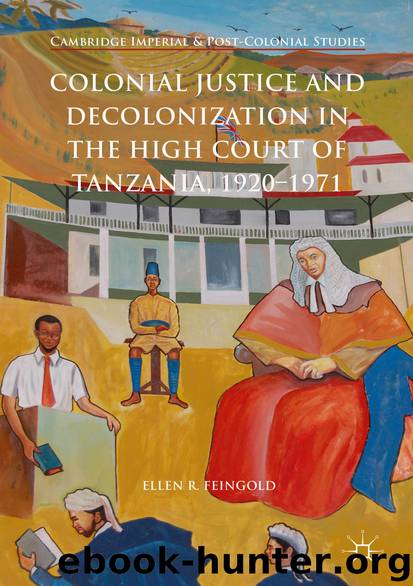Colonial Justice and Decolonization in the High Court of Tanzania, 1920-1971 by Ellen R. Feingold

Author:Ellen R. Feingold
Language: eng
Format: epub
Publisher: Springer International Publishing, Cham
5. Restructuring Colonial Justice, Empowering the High Court, 1959–1964
Ellen R. Feingold1
(1)Georgetown University, Washington, DC, USA
Political progress towards independence in Tanganyika rapidly accelerated in the late 1950s, with a chain of general elections during 1958–1960 and the subsequent establishment of full internal self-government in May 1961.1 Violent clashes in neighbouring Kenya and Nyasaland in 1959—and a strong desire in London to avoid similar events in Tanganyika—helped expedite Tanganyika’s final independence negotiations.2 On 9 December 1961 Tanganyika became the first territory in East Africa to become independent from Great Britain. Though the ‘wind of change’ was blowing powerfully in the political spheres of Tanganyika, it stopped at the doors of the new High Court in Dar es Salaam.3 Initially, it seemed the High Court was in the eye of a storm, remaining unaltered while political and social change swirled around it. One officer working at the High Court at the time recalled that he felt ‘protected from changes so far behind the portals of the High Court’ although there were ‘rapid changes going on’ outside.4 Inside the courtroom trials carried on as they had before independence and there were few indications of the momentous transformations taking place in the Tanganyikan government.
After national independence in 1961 Tanganyika’s political leadership had to decide whether and how to integrate the colonial courts into the new government. The changes the government chose to make to the colonial court systems were reactions to the ways in which the jurisdictions and authorities of the courts, as well as their position relative to the administration, had reinforced British administrative hegemony. Africans had been prevented from accessing the High Court, their cases placed under the supervision of administrators, and they had been barred from participating in the administration of justice outside the sphere of the Local Courts. The government addressed these forms of exclusion through a series of changes to the court system that can be divided into two categories: structure and personnel. The government’s first priority in relation to the courts was to remove the legacy of racial inequality before the courts that had limited Africans’ access to the High Court. Therefore, the government sought to alter the ‘parallel’ structure of the court systems that had reflected and reinforced colonial racial divisions, replacing the colonial court systems with a single system equally accessible to everyone. It then began to increase the participation of Africans in the administration of justice at the highest levels through making efforts to replace colonial judges with African judges. This chapter examines how the government approached decolonising the structure of the colonial court systems and the judiciary’s relationship to the executive. The following two chapters examine the decolonisation of the High Court Bench and the individual judges who were a part of this process. Taken together these three chapters offer an approach to assessing how colonial High Courts transitioned to local institutions.
The government’s decisions in relation to decolonisation of the structure of the colonial court systems were connected to Nyerere and TANU ’s political agenda.
Download
This site does not store any files on its server. We only index and link to content provided by other sites. Please contact the content providers to delete copyright contents if any and email us, we'll remove relevant links or contents immediately.
| Africa | Americas |
| Arctic & Antarctica | Asia |
| Australia & Oceania | Europe |
| Middle East | Russia |
| United States | World |
| Ancient Civilizations | Military |
| Historical Study & Educational Resources |
Goodbye Paradise(3672)
Men at Arms by Terry Pratchett(2754)
Tobruk by Peter Fitzsimons(2420)
Arabs by Eugene Rogan(2239)
Pirate Alley by Terry McKnight(2158)
Borders by unknow(2155)
Belonging by Unknown(1781)
It's Our Turn to Eat by Michela Wrong(1636)
The Biafra Story by Frederick Forsyth(1592)
Botswana--Culture Smart! by Michael Main(1515)
The Source by James A. Michener(1506)
A Winter in Arabia by Freya Stark(1481)
Gandhi by Ramachandra Guha(1466)
Coffee: From Bean to Barista by Robert W. Thurston(1458)
Livingstone by Tim Jeal(1425)
The Falls by Unknown(1410)
The Shield and The Sword by Ernle Bradford(1339)
Africa: Altered States, Ordinary Miracles by Richard Dowden(1328)
Egyptian Mythology A Fascinating Guide to Understanding the Gods, Goddesses, Monsters, and Mortals (Greek Mythology - Norse Mythology - Egyptian Mythology) by Matt Clayton(1306)
